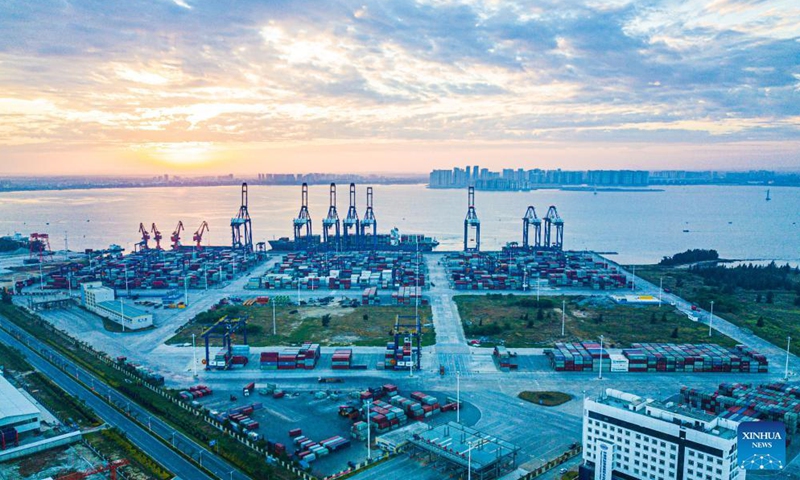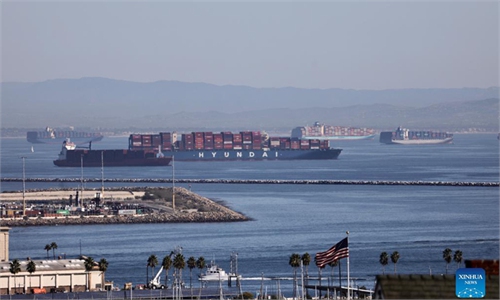US’ port congestions drive up freight rates in Southeast Asia
Rising costs fueled by booming trade, US port congestions

Aerial photo taken on Dec. 5, 2021 shows the sunrise scenery of the Yangpu international container port at Yangpu economic development zone in south China's Hainan Province.Photo:Xinhua
Ports in some Southeast Asian countries have encountered a new round of freight rate surge since late November, driven by US port congestions and booming market demand for much-needed Chinese goods less than two months before the Chinese New Year, Chinese industry insiders and analysts said on Wednesday.
Rates for 40-foot equivalent unit (FEU) containers have tripled, while major ports in Vietnam and Thailand, and some ports in Indonesia and Malaysia, have all witnessed conspicuous growth in freight rates by up to $3,000, a record high, according to industry insiders. It was just about $1,000 in the first half of the year.
While global logistics hurdles caused by US port congestion continue to ferment, industry insiders said that freight rates in Southeast Asian countries will continue to go up and are likely to reach $5,000 per FEU, an unprecedented high level for decades.
While there are multiple reasons for recent rate increases, one conceivable cause is the lingering impact on global transportation capacity of US port congestion, which has seen no substantive improvement after a year-long logjam, industry insiders said.
Shipping companies have diverted some of their ships to serve distant routes such as the ones between China and the US or Europe, where capacity is running short, and consequently freight rates for Southeast Asian routes are going up, Roy Yang, general manager of Zhejiang Yongda International Forwarding Agency, a trader based in Yiwu, East China's Zhejiang Province, told the Global Times on Wednesday.
Yang said that the rate at the port of Jakarta in Indonesia or Bangkok in Thailand was $1,000 per FEU in the first half of the year, and it has now tripled to around $3,500.
The rate surge gradually started in November but got worse in December amid high demand for Chinese goods ahead of the Chinese New Year. Many in Southeast Asian countries also celebrate the Lunar New Year.
Several domestic traders and suppliers have already been affected by the higher price.
A manager at a small home appliance plant based in South China's Guangzhou said that the company has been producing and delivering goods mostly to Southeast Asian markets before the Chinese New Year, but it takes an extra four to six days now to get containers and slots, and costs are higher.
"Although it's still around two months until the Chinese New Year, we are working around the clock to get our products delivered, because prices are rising," he said.
But insiders said that the current situation, although it has come at short notice, is still manageable at the moment.
The Guangzhou-based factory manager said that he is negotiating with clients in Indonesia, Thailand and some other neighboring countries over the potential disruption caused by the longer waiting times for slots and higher transportation costs, while also finding other alternative ports to divert risks.
Other industry insiders that the Global Times reached on Wednesday are providing container-share and group delivery services for suppliers who cannot find containers on time.
But experts said what is happening in Southeast Asia is incomparable to the "holy mess" in the US, where port congestion has continued for a long time and the freight rates between China and the US coasts quadrupled compared with last year, and the waiting time for ships after arriving at some US ports can be up to two weeks due to labor shortage and low automation rates.
"There are many ports in Southeast Asian countries, so that there tend to be more options for traders if one port is jammed… also, ports in the region are largely under normal operation and they have relatively high automation rates," Wu Minghua, a Shanghai-based veteran shipping industry analyst, told the Global Times.
Rising freight rates are also a reflection of booming trade in the whole region, fuelled by the regional demand for closer cooperation and market opening-up, experts said.
From January to November, ASEAN remained China's largest trading partner, with total bilateral trade of 5.11 trillion yuan ($804 million), a year-on-year increase of 20.6 percent, according to the General Administration of Customs on Tuesday.
Driven by the trend, Wu said that freight rates in the region may continue to go up and are likely to reach $5,000 per FEU before the Chinese New Year, an unprecedented level for decades.

